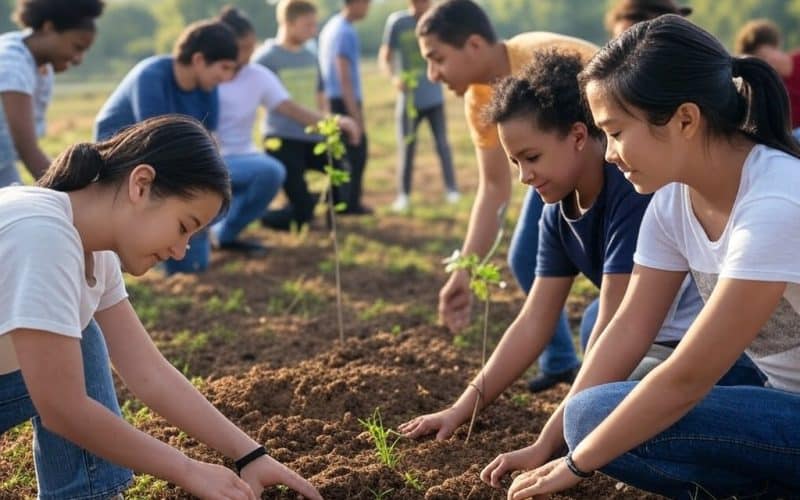
Empowering students to spearhead sustainability development projects nurtures environmental awareness and fuels imaginative problem-solving. Connecting classroom projects with the United Nations’ Sustainable Development Goals (SDGs) equips learners with tangible skills and deep-rooted accountability in sustainability development projects.
Implementing frameworks like the Eco-Schools program motivates students to enhance their schools through waste reduction and energy conservation. Infusing sustainability into project-based learning prompts them to engage with real-world dilemmas and devise innovative solutions. By providing targeted resources, mentorship, and firsthand experience, educators spark proactive leadership in sustainability efforts.
Engaging in sustainability development projects allows students to address real-world issues effectively and creatively. In this article we are going to give you 7 steps you can follow to make your projects a success. We also added a practical example, namely a Zero-Waste Cafeteria Project.
How Can Teachers Empower Student Sustainability Development Projects?
Igniting young minds to create lasting environmental solutions is a dream for every teacher. A good way is to combine real-world challenges with hands-on exploration to produce strong project outcomes.
These sustainability development projects not only enhance practical skills but also foster a sense of community responsibility. Through sustainability development projects, students learn the importance of collaboration and innovation in tackling environmental challenges.
Follow these steps to guide students in developing a meaningful sustainability development project:
- Set Clear, Inspiring Goals
Define a compelling objective. Focus on precise outcomes, such as reducing classroom waste by 50% or installing a community garden with raised beds. Ensure everyone understands the mission from the start. - Assemble an Enthusiastic Team
Gather students, teachers, and local experts. Encourage them to pool diverse skills. Involve science enthusiasts, marketing whizzes, and artistic thinkers. This synergy motivates broader innovation. - Craft a Concrete Timeline
Outline key milestones and deadlines. Assign tasks like researching recycling systems, designing promotional materials, and scheduling workshops. Use project-management tools to track progress. Maintain momentum by celebrating each completed milestone. - Spark Interactive Learning
Incorporate practical experiments and field activities. Host energy audits on campus to spotlight cost savings and carbon reductions. Visit local recycling centers to expose students to real-world processes. Hands-on experiences enrich their understanding of sustainability concepts. - Engage the Community
Promote the project through newsletters, social media updates, and school events. Share progress data and successes. Invite volunteers for planting days or clean-up drives. Involve local businesses by requesting donations of eco-friendly materials. - Measure and Adapt
Evaluate progress weekly or monthly. Track data points like reduced electricity usage, decreased plastic consumption, or compost volumes. Adjust the plan if goals need recalibration. Teach students to interpret metrics and refine strategies on the fly. - Celebrate and Scale
Showcase accomplishments at a final event. Invite stakeholders, showcase before-and-after snapshots, and recognize standout efforts. Document lessons learned. Then expand the project or replicate it in nearby schools for larger impact.
Important in all this is to encourage creativity at each and every phase of your sustainability development project. Place students at the center, letting them shape ideas and drive outcomes. This approach instills ownership and hones problem-solving skills.
Practical Example of a Sustainability Development Project in 7 Steps: Zero-Waste Cafeteria Project
Ultimately, the success of sustainability development projects hinges on the creativity and commitment of the students involved.
Let’s try to implement this for an imaginary ‘Zero-Waste Cafeteria Project’. We will implement the 7 steps merging hands-on engagement with concrete impact for a sustainability development project, and we also describe what tools you can use when working on this sustainability development project.
- “Set Clear, Inspiring Goals”.
Aim to cut cafeteria waste by 30% in three months. Use kitchen scales and digital logging apps like Google Sheets to track daily waste levels. Post visual reminders that highlight the target percentage, keeping your team focused on the end result. - “Assemble an Enthusiastic Team”.
Include students, faculty, cafeteria staff, and community experts. Employ collaboration platforms such as Slack, Trello, or shared Google Drive folders to distribute tasks and share updates. Integrate chat groups or forums to keep everyone connected. - “Craft a Concrete Timeline”.
Break the project into manageable phases. Implement weekly check-ins via project management software like Asana or Trello. Assign due dates for tasks such as purchasing compost bins, launching awareness campaigns, and analyzing early data. - “Spark Interactive Learning”.
Provide sessions on food waste measurement and composting basics. Use simple tools: durable gloves, clear labeling systems, and small handheld scales. Organize field trips to recycling centers or local farms where compost is utilized. Encourage active data collection and reflection. - “Engage the Community”.
Launch your campaign on social media and in newsletters. Share progress reports and fun graphics created with design platforms like Canva. Invite local businesses to donate compostable materials. Maintain open channels for feedback and involvement. - “Measure and Adapt”.
Keep an ongoing record of daily or weekly waste outputs in a shared online spreadsheet. Use analytics tools, such as Google Looker Studio, to spot trends and identify quick wins (like switching from plastic cutlery to reusable alternatives). Adjust targets if new metrics show a different approach would yield faster waste reduction. - “Celebrate and Scale”.
Host a Zero-Waste Celebration. Display charts or infographics that illustrate before-and-after waste levels. Reward standout contributors with public recognition or eco-themed prizes. Document all procedures, from best practices to lessons learned. Expand the concept to other areas on campus or collaborate with neighboring schools to extend its reach.
This method promotes a sense of responsibility and enhances critical thinking abilities. The effectiveness of sustainability initiatives of course relies on the students’ dedication and innovative approaches. When applied to the hypothetical ‘Zero-Waste Cafeteria Project’ as developed, the seven-step process integrates practical involvement with tangible outcomes, demonstrating the tools necessary for executing such sustainability projects successfully.
